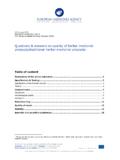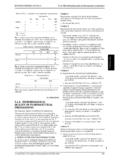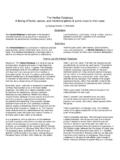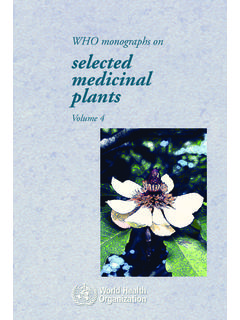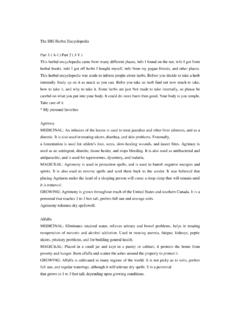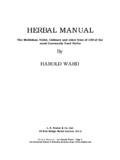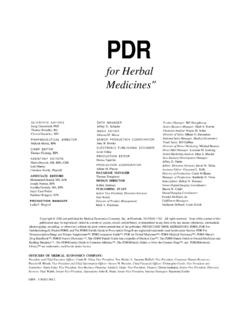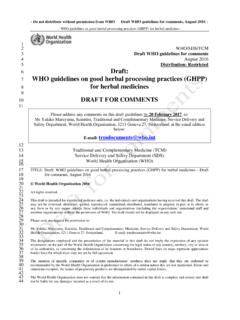Transcription of Reflection paper on microbiological aspects of …
1 4 June 2015. EMA/HMPC/95714/2013. Committee on herbal medicinal Products (HMPC). Reflection paper on microbiological aspects of herbal medicinal products and traditional herbal medicinal products Final Draft agreed by HMPC drafting group on quality January 2014. Draft adopted by Committee on herbal medicinal 28 January 2014. Products (HMPC). Start of public consultation 19 February 2014. End of consultation (deadline for comments) 15 June 2014. Agreed by HMPC drafting group on quality March 2015. Adopted by HMPC 5 May 2015. Keywords HMPC; herbal medicinal products; traditional herbal medicinal products; herbal substances; herbal preparations; quality; microbiological aspects ; microbial decontamination.
2 30 Churchill Place Canary Wharf London E14 5EU United Kingdom Telephone +44 (0)20 3660 6000 Facsimile +44 (0)20 3660 5555. Send a question via our website An agency of the European Union European Medicines Agency, 2015. Reproduction is authorised provided the source is acknowledged. Table of contents 1. Introduction .. 3. 2. Discussion .. 4. Minimizing microbial contamination by prevention .. 5. herbal substances .. 6. herbal preparations .. 6. herbal medicinal 6. Methods for reduction of microbial contamination .. 7. Justification for applying a decontamination process .. 7. Choice of decontamination method .. 8. herbal substances .. 12.. herbal preparations .. 12. herbal medicinal 12. Testing of the herbal substance, herbal preparation, and herbal medicinal product .
3 13. herbal substances .. 16. herbal preparations .. 17. herbal medicinal 17. 3. Conclusion .. 17. 4. Definitions .. 18. 5. References .. 20. Reflection paper on microbiological aspects of herbal medicinal products and traditional herbal medicinal products EMA/HMPC/95714/2013 Page 2/22. 1. Introduction Directive 2001/83/EC as amended and Directive 2001/82/EC as amended provide definitions for herbal substances, herbal preparations, and herbal medicinal products (HMPs) 1. The basic legislation applies to both HMPs for human and veterinary use 2. An additional simplified registration procedure has been established for traditional herbal medicinal products (THMPs) for human use under Directive 2004/24/EC.
4 The principles of this Reflection paper apply equally to such THMPs. According to these definitions a herbal medicinal product is any medicinal product , exclusively containing as active ingredients one or more herbal substances or one or more herbal preparations, or one or more such herbal substances in combination with one or more such herbal preparations. THMPs may also contain vitamins and minerals, provided that the action of the vitamins and minerals is ancillary to that of the active herbal ingredient(s). HMPs have a number of characteristics that differentiate them from medicinal products containing chemically defined active substances. Specific guidelines have therefore been established for HMPs which cover particular aspects that general guidelines do not.
5 herbal substances and herbal preparations are complex mixtures of natural constituents and, potentially, also contaminants, with a natural variability. Being of natural origin herbal substances generally have a higher microbial content compared to chemical drug substances. In this Reflection paper consideration is given as to how suitable microbial quality of herbal substances, herbal preparations, and HMPs can be achieved by preventative measures, manufacturing processes and by applying decontamination processes. The aim of the Reflection paper is to provide an overview of the critical aspects to be taken into account to ensure suitable microbial quality. The focus is on current regulatory aspects , but aspects of GACP and GMP are discussed as well.
6 Methods of sterilisation and the microbiological quality of herbal substances, herbal preparations and herbal medicinal products for sterile dosage forms are not covered by this paper . 1 The term herbal substance should be considered as equivalent to the term herbal drug as defined in the European Pharmacopoeia, and the term herbal preparation should be considered as equivalent to the term herbal drug preparation as defined in the European Pharmacopoeia. 2 Directive 2001/83/EC as amended and Directive 2001/82/EC as amended. Reflection paper on microbiological aspects of herbal medicinal products and traditional herbal medicinal products EMA/HMPC/95714/2013 Page 3/22. 2. Discussion The active ingredients of HMPs are herbal substances and/or herbal preparations derived from herbal substances.
7 Being of natural origin, the active ingredients in HMPs tend to have higher microbial contamination (bioburden) than chemically defined active substances and the microbial population present may differ qualitatively and quantitatively. Therefore, particular attention should be paid to the microbiological quality of HMPs. The European Pharmacopoeia (Ph. Eur.) recognises the need to allow wider acceptance criteria for the microbial quality HMPs depending on the nature of the product and method of preparation herbal teas. herbal substances/preparations may be contaminated with numerous species of bacteria and fungi (yeasts and moulds). Viruses are not usually considered to be a concern with herbal substances/preparations.
8 The content of viable bacteria, fungi and their spores should be determined and limited in herbal substances/preparations and HMPs in accordance with the provisions of the Pathogenic micro-organisms Pathogenic bacterial species pose a risk of inducing infectious diseases or other unwanted effects in patients taking the HMP. Such micro-organisms should not be present in the HMP. Spores Endospores are bacterial spores formed by certain Gram-positive bacteria Bacillus and Clostridium species. Spores are formed when bacteria are exposed to unfavourable environmental conditions (heat, drought, irradiation or depletion of nutrients). Generally, a higher number of spores are found in dry herbal substances compared to fresh herbal substances, especially when inappropriate drying procedures are used.
9 Bacterial spores are highly resistant to various environments (desiccation, freezing, dry heating, vapour, elevated pressure, UV radiation and various chemicals including extraction solvents such as ethanol). Bacterial spores have the potential to be reactivated into the vegetative state as bacteria when favourable environmental conditions are present again. Nutrients and elevated temperatures are used during the incubation phase of testing of total aerobic microbial count (TAMC; Ph. Eur. , , ) of a product and thus spores of certain bacterial species (mostly aerobic from Bacillus spp.) are detected together with the bacteria by these quantitative in vitro methods. Fungi, and particularly moulds, also produce spores (conidia).
10 However, they are generally not as resistant as bacterial spores to unfavourable environmental conditions. Physicochemical characteristics From a quality point of view, some micro-organisms can alter the physicochemical characteristics of the product which may lead to detrimental changes to the product 's quality. Constituents of the plant material may be metabolised by the micro-organism, leading to undesirable chemical changes. Micro-organisms may also lead to sensory changes (appearance, smell, or taste) and to changes in pH. of the HMP, due to metabolic substances formed by the micro-organism. If the pH changes significantly in a HMP containing a chemically ionisable preservative and the efficacy of that preservative is pH.










